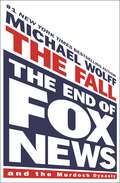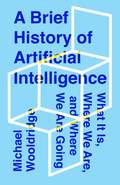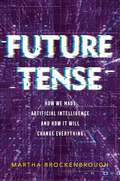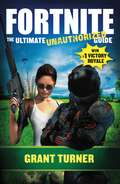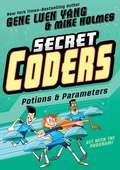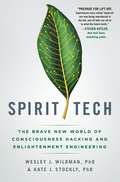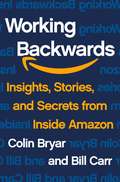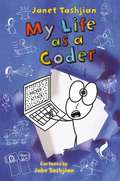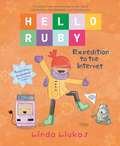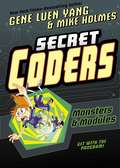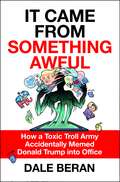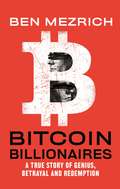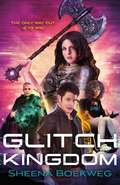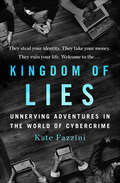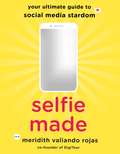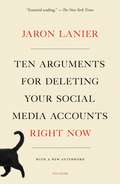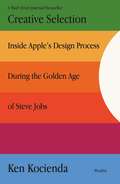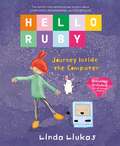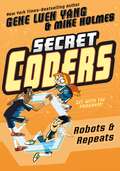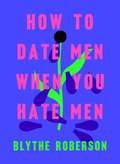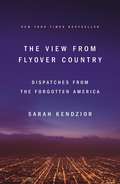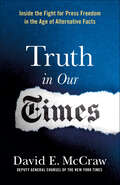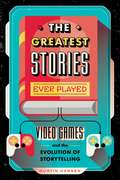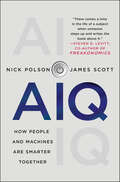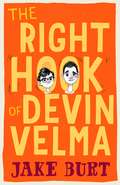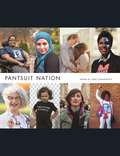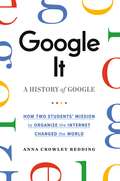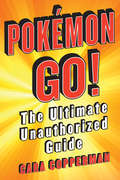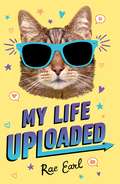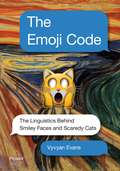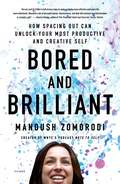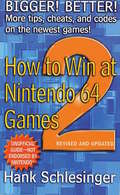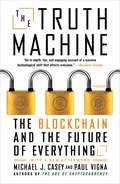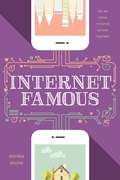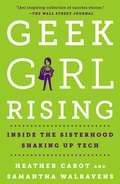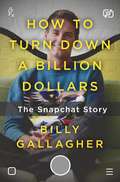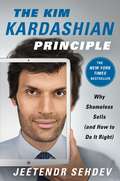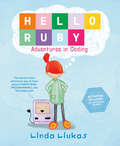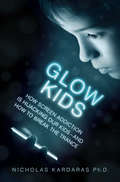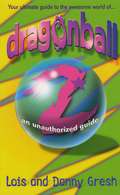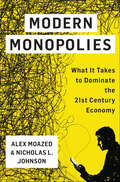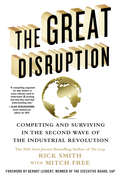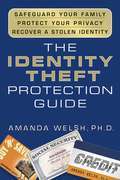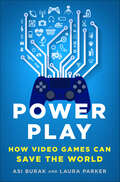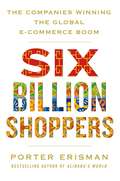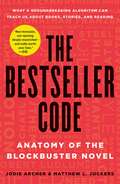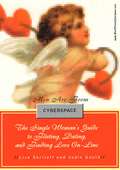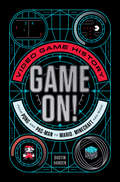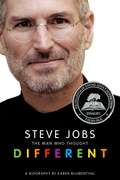- Table View
- List View
A Framework for K-12 Science Education
by Helen QuinnScience, engineering, and technology permeate nearly every facet of modern life and hold the key to solving many of humanity's most pressing current and future challenges. The United States' position in the global economy is declining, in part because U. S. workers lack fundamental knowledge in these fields. To address the critical issues of U. S. competitiveness and to better prepare the workforce, A Framework for K-12 Science Education proposes a new approach to K-12 science education that will capture students' interest and provide them with the necessary foundational knowledge in the field. A Framework for K-12 Science Education outlines a broad set of expectations for students in science and engineering in grades K-12. These expectations will inform the development of new standards for K-12 science education and, subsequently, revisions to curriculum, instruction, assessment, and professional development for educators. This book identifies three dimensions that convey the core ideas and practices around which science and engineering education in these grades should be built. These three dimensions are: crosscutting concepts that unify the study of science through their common application across science and engineering; scientific and engineering practices; and disciplinary core ideas in the physical sciences, life sciences, and earth and space sciences and for engineering, technology, and the applications of science. The overarching goal is for all high school graduates to have sufficient knowledge of science and engineering to engage in public discussions on science-related issues, be careful consumers of scientific and technical information, and enter the careers of their choice. A Framework for K-12 Science Education is the first step in a process that can inform state-level decisions and achieve a research-grounded basis for improving science instruction and learning across the country. The book will guide standards developers, teachers, curriculum designers, assessment developers, state and district science administrators, and educators who teach science in informal environments.
The Fall: The End of Fox News and the Murdoch Dynasty
by Michael WolffNew York Times Bestseller“All happy families are alike; each unhappy family is unhappy in its own way.”—Leo Tolstoy, Anna Karenina“Michael Wolff’s books were my foundation and port of entry for working on Succession.” —Jeremy Strong (“Kendall Roy”)Meet the Murdochs and the disastrously dysfunctional family of Fox News. Until recently, they formed the most powerful media and political force in the land, for better or worse. Now their empire is cracking up and crashing down.For almost three decades, Fox News has not only made political careers (see: President Donald J. Trump) but also fundamentally altered the political landscape of the United States. It is a truism: as Fox goes, so goes the nation—into further divisiveness and awash in fake news, a gleefully polarizing company. But just as Fox has pushed America apart, now it too is coming apart. As is the family dynasty behind it.In his irresistible trilogy on the chaotic presidency of Donald Trump—Fire and Fury, Siege, and Landslide—the gadfly journalist Michael Wolff led readers deep into the twisted corridors of the White House. Now, drawing on years of unprecedented access to the Murdoch family and key players in the world of Fox, he plunges us behind the scenes of another empire of influence, and the result is astonishing and unforgettable.Here is Rupert Murdoch, the ninety-two-year-old Australian billionaire—a fading titan, concerned about his legacy but more concerned about profits. Here are his contentious progeny, jockeying to take over when the old man is gone. Here is star anchor Tucker Carlson, hiding out in his island homes, considering a run for the presidency while his bosses have other plans for him. Sean Hannity, the richest man in television, has his own plans: to put the former POTUS back in office, against the bosses’ wishes. Meanwhile, Laura Ingraham is just trying to survive in the last man’s man’s world.Empires fall. Kingdoms come to an end. As lawsuits pummel the financial bedrock and reputation of the network, anchors scramble, and the battling Murdoch heirs make the Roys of TV’s Succession seem downright Brady Bunch, Michael Wolff documents, in riveting and revelatory real time, the final days of Fox News.
Ava in Code Land
by Jess Hitchman Gavin CullenA little girl must use her coding skills to save her video-game home in Ava in Code Land, an adorable debut picture book by Jess Hitchman and Gavin Cullen, illustrated by Liere Martin.Ava thinks living in a video game is pretty cool. She and her cat, Pixels, spend their days riding breakfast rollercoasters and heading to underwater discos. And if something isn't exactly perfect, Ava can reprogram the world to be just the way she likes it. But then the game's villain, Max Hacksalot, comes along on his magical pirate unicorn and breaks all of Ava's code. When Max manages to send them all to the Game Over screen, it's up to Ava and her coding skills to save the day!
A Brief History of Artificial Intelligence: What It Is, Where We Are, and Where We Are Going
by Michael WooldridgeFrom Oxford's leading AI researcher comes a fun and accessible tour through the history and future of one of the most cutting edge and misunderstood field in science: Artificial IntelligenceThe somewhat ill-defined long-term aim of AI is to build machines that are conscious, self-aware, and sentient; machines capable of the kind of intelligent autonomous action that currently only people are capable of. As an AI researcher with 25 years of experience, professor Mike Wooldridge has learned to be obsessively cautious about such claims, while still promoting an intense optimism about the future of the field. There have been genuine scientific breakthroughs that have made AI systems possible in the past decade that the founders of the field would have hailed as miraculous. Driverless cars and automated translation tools are just two examples of AI technologies that have become a practical, everyday reality in the past few years, and which will have a huge impact on our world.While the dream of conscious machines remains, Professor Wooldridge believes, a distant prospect, the floodgates for AI have opened. Wooldridge's A Brief History of Artificial Intelligence is an exciting romp through the history of this groundbreaking field--a one-stop-shop for AI's past, present, and world-changing future.
Future Tense: How We Made Artificial Intelligence—and How It Will Change Everything
by Martha BrockenbroughHuman history has always been shaped by technology, but AI is like no technology that has come before it. Unlike the wheel, combustion engines, or electricity, AI does the thing that humans do best: think. While AI hasn’t reproduced the marvelously complex human brain, it has been able to accomplish astonishing things. AI has defeated our players at games like chess, Go, and Jeopardy!. It’s learned to recognize objects and speech. It can create art and music. It’s even allowed grieving people to feel as though they were talking with their dead loved ones.On the flip side, it’s put innocent people in jail, manipulated the emotions of social media users, and tricked people into believing untrue things.In this non-fiction book for teens, acclaimed author and teacher Martha Brockenbrough guides readers through the development of this world-changing technology, exploring how AI has touched every corner of our world, including education, healthcare, work, politics, war, international relations, and even romance. This is essential reading for anyone who wants to understand how artificial intelligence got here, how to make the best use of it, and how we can expect it to transform our lives.
Fortnite: The Ultimate Unauthorized Guide
by Grant TurnerThe only how-to and strategy guide you need to be the last player standing in the hottest video game on earth!Are you ready to take your game to the next level and dominate your opponents? Ready to learn how to destroy your fellow gamers and win the ultimate Battle Royale? If so, you're ready for Fortnite: The Ultimate Unauthorized Guide.Starting with simple instructions on how to download and install the game on all platforms (Nintendo, PlayStation, Xbox and PC--and now on your mobile device!), Fortnite: The Ultimate Unauthorized Guide divulges all the essential information needed to navigate through the Fortnite world like a pro.Whether playing Battle Royale or Save the Earth mode, readers will learn how and where to unearth the best items, discover essential combat strategies and weapons use, identify ideal landing zones and build the perfect fort or base. Also included are maneuvering tactics and even advice on how to manage resources and cash, buying the coolest skin and flashing the best dance moves. With secret cheats, hacks, unlockables, and much more, this is an essential guide to everything Fortnite!
Secret Coders: Potions & Parameters (Secret Coders #5)
by Gene Luen YangFrom graphic novel superstar (and former computer programming teacher) and New York Times bestselling author Gene Luen Yang, Secret Coders: Potions & Parameters is the fifth volume in a wildly entertaining series that combines logic puzzles and basic coding instruction with a page-turning mystery plot!Dr. One-Zero won't stop until the whole town—no, the whole world—embraces the "true happiness” found in his poisonous potion, Green Pop. And now that he has the Turtle of Light, he’s virtually unstoppable.There's one weapon that can defeat him: another Turtle of Light. Unfortunately, they can only be found in another dimension! To open a portal to this new world, Hopper, Eni, and Josh's coding skills will be put to the test.
Spirit Tech: The Brave New World of Consciousness Hacking and Enlightenment Engineering
by Wesley J. Wildman Kate J. StocklyFeaturing a Foreword by Mikey Siegel, founder of Consciousness Hacking. Technology can now control the spiritual experience. This is a journey through the high-tech aids for psychological growth that are changing our world, while exploring the safety, authenticity and ethics of this new world.We already rely on technology to manage our health, sleep, relationships, and finances, so it’s no surprise that we’re turning to technological aids for the spiritual journey. From apps that help us pray or meditate, to cybernauts seeking the fast track to nirvana through magnetic brain stimulation, we are on the brink of the most transformative revolution in the practice of religion: an era in which we harness the power of “spirit tech” to deepen our experience of the divine.Spirit tech products are rapidly improving in sophistication and power, and ordinary people need a trustworthy guide. Through their own research and insiders’ access to the top innovators and early adopters, Wesley J. Wildman and Kate J. Stockly take you deep inside an evolving world:- Find out how increasingly popular “wearables” work on your brain, promising a shortcut to transformative meditative states.- Meet the inventor of the “God Helmet” who developed a tool to increase psychic skills, and overcome fear, sadness, and anger.- Visit churches that use ayahuasca as their sacrament and explore the booming industry of psychedelic tourism.- Journey to a mansion in the heart of Silicon Valley where a group of scientists and entrepreneurs are working feverishly to bring brain-based spirit tech applications to the masses.- Discover a research team who achieved brain-to-brain communication between individuals thousands of miles apart, harnessing neurofeedback techniques to sync and share emotions among group members.Spirit Tech offers readers a compelling glimpse into the future and is the definitive guide to the fascinating world of new innovations for personal transformation, spiritual growth, and pushing the boundaries of human nature.
Working Backwards: Insights, Stories, and Secrets from Inside Amazon
by Colin Bryar Bill CarrWorking Backwards is an insider's breakdown of Amazon's approach to culture, leadership, and best practices from two long-time Amazon executives.Colin started at Amazon in 1998; Bill joined in 1999. In Working Backwards, these two long-serving Amazon executives reveal and codify the principles and practices that drive the success of one of the most extraordinary companies the world has ever known. With twenty-seven years of Amazon experience between them, much of it in the early aughts—a period of unmatched innovation that brought products and services including Kindle, Amazon Prime, Amazon Studios, and Amazon Web Services to life—Bryar and Carr offer unprecedented access to the Amazon way as it was refined, articulated, and proven to be repeatable, scalable, and adaptable.With keen analysis and practical steps for applying it at your own company—no matter the size—the authors illuminate how Amazon’s fourteen leadership principles inform decision-making at all levels and reveal how the company’s culture has been defined by four characteristics: customer obsession, long-term thinking, eagerness to invent, and operational excellence. Bryar and Carr explain the set of ground-level practices that ensure these are translated into action and flow through all aspects of the business.Working Backwards is a practical guidebook and a corporate narrative, filled with the authors’ in-the-room recollections of what “Being Amazonian” is like and how it has affected their personal and professional lives. They demonstrate that success on Amazon’s scale is not achieved by the genius of any single leader, but rather through commitment to and execution of a set of well-defined, rigorously-executed principles and practices—shared here for the very first time.
My Life as a Coder (The My Life series #9)
by Janet TashjianMy Life as a Coder is the ninth book in Janet Tashjian's much-loved, diary fiction My Life series starring reluctant reader Derek Fallon, featuring illustrations by Jake Tashjian.Derek Fallon receives an exciting new gift--a laptop! But there's a catch: it has no Wi-Fi so he can't use it for gaming. If he wants to play computer games, he'll have to learn how to code them himself. Another unforgettable adventure awaits in Book 9 of the My Life series, this time involving tech and coding!Christy Ottaviano Books
Hello Ruby: Expedition to the Internet (Hello Ruby #3)
by Linda LiukasWelcome back to the world's most whimsical way to learn about technology and coding in Hello Ruby: Expedition to the Internet, as Linda Liukas, a programming superstar, teaches kids all about the internet through storytelling and imaginative activities.What exactly is the Internet? Is it a cloud? A network of wires? How does the information travel online? Learn all this and more with Ruby!In Ruby’s world anything is possible if you put your mind to it—even building the Internet out of snow! But before you can build something, you need to understand what it is and how it works. Join Ruby and her friends in their quest to build the most amazing Snow Internet ever, while learning real life facts along the way. Then, future kid coders can put their knowledge and imaginations to the test with the fun and creative exercises included in the activity book section.
Secret Coders: Monsters & Modules (Secret Coders #6)
by Gene Luen YangFrom graphic novel superstar (and former computer programming teacher) and New York Times bestselling author Gene Luen Yang, Secret Coders: Monsters & Modules is the sixth and final volume in a wildly entertaining series that combines logic puzzles and basic coding instruction with a page-turning mystery plot!The Coders always knew their programming skills would take them far, but they never guessed they would take them to another dimension! Or to be accurate, one dimension less—to save humanity, Hopper, Eni, and Josh must travel to Flatland, a dangerous two-dimensional world ruled by polygons. If they can return home safely with a turtle of light, they might just stand a chance in their final showdown with Dr. One-Zero!
It Came from Something Awful: How a Toxic Troll Army Accidentally Memed Donald Trump into Office
by Dale BeranAn insider's history of the website at the end of the world, which burst into politics and memed Donald Trump into the White House.The internet has transformed the ways we think and act, and by consequence, our politics. The most impactful recent political movements on the far left and right started with massive online collectives of teenagers. Strangely, both movements began on the same website: an anime imageboard called 4chan.org. It Came from Something Awful is the fascinating and bizarre story of 4chan and its profound effect on youth counterculture.Dale Beran has observed the website's shifting activities and interests since the beginning. 4chan is a microcosm of the internet itself—simultaneously at the vanguard of contemporary culture, politics, comedy and language, and a new low for all of the above. It was the original meme machine, mostly frequented by socially awkward and disenfranchised young men in search of a place to be alone together.During the recession of the late 2000’s, the memes became political. 4chan was the online hub of a leftist hacker collective known as Anonymous and a prominent supporter of the Occupy Wall Street movement. But within a few short years, the site’s ideology spun on its axis; it became the birthplace and breeding ground of the alt-right. In It Came from Something Awful, Beran uses his insider’s knowledge and natural storytelling ability to chronicle 4chan's strange journey from creating rage-comics to inciting riots to—according to some—memeing Donald Trump into the White House.
Bitcoin Billionaires: A True Story of Genius, Betrayal, and Redemption
by Ben MezrichFrom Ben Mezrich, the New York Times bestselling author of The Accidental Billionaires and Bringing Down the House, comes Bitcoin Billionaires--the fascinating story of brothers Tyler and Cameron Winklevoss's big bet on crypto-currency and its dazzling pay-off. Ben Mezrich's 2009 bestseller The Accidental Billionaires is the definitive account of Facebook's founding and the basis for the Academy Award–winning film The Social Network. Two of the story's iconic characters are Harvard students Tyler and Cameron Winklevoss: identical twins, Olympic rowers, and foils to Mark Zuckerberg. Bitcoin Billionaires is the story of the brothers’ redemption and revenge in the wake of their epic legal battle with Facebook. Planning to start careers as venture capitalists, the brothers quickly discover that no one will take their money after their fight with Zuckerberg. While nursing their wounds in Ibiza, they accidentally run into an eccentric character who tells them about a brand-new idea: cryptocurrency. Immersing themselves in what is then an obscure and sometimes sinister world, they begin to realize “crypto” is, in their own words, "either the next big thing or total bulls--t." There’s nothing left to do but make a bet. From the Silk Road to the halls of the Securities and Exchange Commission, Bitcoin Billionaires will take us on a wild and surprising ride while illuminating a tantalizing economic future. On November 26, 2017, the Winklevoss brothers became the first bitcoin billionaires. Here’s the story of how they got there—as only Ben Mezrich could tell it.
Glitch Kingdom
by Sheena BoekwegThe teenage daughter of an executioner and the traitorous prince she can’t kill must reluctantly join forces to dethrone a paranoid queen after discovering they are trapped in a video game in Sheena Boekweg's fast-paced YA debut, Glitch Kingdom...Ryo was the golden boy, the prankster prince, but with one stroke of a pen he has lost everything. Dagney and Grigfen were happy as minor members of the court, but when their father, the king's executioner, is branded a traitor, they each must deal in death in order to survive.. McKenna, queen of the enemy realm, has inherited a mission of conquest by assassination, but worries she's not up to the role. But behind the crowns and masks hides a secret… All of these teens are actually players in the newest, shiniest, most immersive virtual reality video game, competing against each other for a highly coveted internship with a prestigious game developer. But now this life-changing opportunity has suddenly become a deadly trap. A glitch in the software has locked the players inside the game, and they’ll need to escape before the fantasy world corrupts around them. The only way out is to win.
Kingdom of Lies: Unnerving Adventures in the World of Cybercrime
by Kate Fazzini“Wow. Kate Fazzini is the rare top-level reporter who can make you see, smell and feel a hidden world, not just understand it. Cybercrime (and security) has found its Michael Lewis.” —Bret Witter, co-author of the #1 NYT bestseller The Monuments MenOne of BookRiot's "50 of the Best Books to Read This Summer"In the tradition of Michael Lewis and Tom Wolfe, a fascinating and frightening behind-the-scenes look at the interconnected cultures of hackers, security specialists, and law enforcementA 19-year-old Romanian student stumbles into a criminal ransomware ring in her village. Soon she is extorting Silicon Valley billionaires for millions--without knowing the first thing about computers.A veteran cybersecurity specialist has built a deep network of top notch hackers in one of the world’s largest banks. But then the bank brings in a cadre of ex-military personnel to “help.” A cynical Russian only leaves his tiny New Jersey apartment to hack sports cars at a high performance shop in Newark. But he opens his door to a consultant who needs his help. A hotel doorman in China once served in the People’s Army, stealing intellectual property from American companies. Now he uses his skills to build up a private side-business selling the data he takes from travelers to Shanghai’s commercial center. Kingdom of Lies follows the intertwined stories of cybercriminals and ethical hackers as they jump from criminal trend to criminal trend, crisis to crisis. A cybersecurity professional turned journalist, Kate Fazzini illuminates the many lies companies and governments tell us about our security, the lies criminals tell to get ahead, and the lies security leaders tell to make us think they are better at their jobs than they are.Like Traffic set in the cybercrime world, Kingdom of Lies is as entertaining as it is eye opening.
Selfie Made: Your Ultimate Guide to Social Media Stardom
by Meridith Valiando RojasHOW DO I MAKE IT BIG ON SOCIAL MEDIA? WHAT IS MY STORY—AND WHO IS MY AUDIENCE? WHAT CONTENT SHOULD I POST TO ACHIEVE #SUCCESS? HOW DO I GO VIRAL…OR HOW LONG WILL IT TAKE ME TO GET NOTICED?Selfie Made is a one-of-a-kind guide to creating a digital identity, finding an audience, and building a powerful brand—your own!—on the Internet. Whether you want to be in front of or behind the camera, produce click-worthy content or start your own business, this book is the place to begin. Written by Meridith Valiando Rojas, the hugely successful (and super friendly IRL) founder of DigiTour who has worked with every major star from YouTube to Musical.ly, this collection of personal anecdotes and professional advice, tricks of the trade and behind-the-screen secrets, will give you everything you need for your social media toolkit.Here, you’ll get to know the true stories behind some of today’s most successful multimedia stars and influencers, including:Max And Harvey - Blake Gray - Danielle CohnBryce Xavier - Lauren Godwin - Nathan TriskaTrevor Moran - Messy Monday - Simon Britton…and others who learned the ropes, beat the odds, and took social media by storm. And so can you!
Ten Arguments for Deleting Your Social Media Accounts Right Now
by Jaron LanierA timely call-to-arms from a Silicon Valley pioneer. <p><p>You might have trouble imagining life without your social media accounts, but virtual reality pioneer Jaron Lanier insists that we’re better off without them. In Ten Arguments for Deleting Your Social Media Accounts Right Now, Lanier, who participates in no social media, offers powerful and personal reasons for all of us to leave these dangerous online platforms. <p>Lanier’s reasons for freeing ourselves from social media’s poisonous grip include its tendency to bring out the worst in us, to make politics terrifying, to trick us with illusions of popularity and success, to twist our relationship with the truth, to disconnect us from other people even as we are more “connected” than ever, to rob us of our free will with relentless targeted ads. <p> How can we remain autonomous in a world where we are under continual surveillance and are constantly being prodded by algorithms run by some of the richest corporations in history that have no way of making money other than being paid to manipulate our behavior? How could the benefits of social media possibly outweigh the catastrophic losses to our personal dignity, happiness, and freedom? <p>Lanier remains a tech optimist, so while demonstrating the evil that rules social media business models today, he also envisions a humanistic setting for social networking that can direct us toward a richer and fuller way of living and connecting with our world.
Creative Selection: Inside Apple's Design Process During the Golden Age of Steve Jobs
by Ken Kocienda* WALL STREET JOURNAL BESTSELLER *An insider's account of Apple's creative process during the golden years of Steve Jobs.Hundreds of millions of people use Apple products every day; several thousand work on Apple's campus in Cupertino, California; but only a handful sit at the drawing board. Creative Selection recounts the life of one of the few who worked behind the scenes, a highly-respected software engineer who worked in the final years of the Steve Jobs era—the Golden Age of Apple. Ken Kocienda offers an inside look at Apple’s creative process. For fifteen years, he was on the ground floor of the company as a specialist, directly responsible for experimenting with novel user interface concepts and writing powerful, easy-to-use software for products including the iPhone, the iPad, and the Safari web browser. His stories explain the symbiotic relationship between software and product development for those who have never dreamed of programming a computer, and reveal what it was like to work on the cutting edge of technology at one of the world's most admired companies.Kocienda shares moments of struggle and success, crisis and collaboration, illuminating each with lessons learned over his Apple career. He introduces the essential elements of innovation—inspiration, collaboration, craft, diligence, decisiveness, taste, and empathy—and uses these as a lens through which to understand productive work culture.An insider's tale of creativity and innovation at Apple, Creative Selection shows readers how a small group of people developed an evolutionary design model, and how they used this methodology to make groundbreaking and intuitive software which countless millions use every day.
Hello Ruby: Journey Inside the Computer (Hello Ruby #2)
by Linda LiukasWhat exactly is a computer? How does it work? What is it made of? Learn all this and more with Ruby!In Ruby's world anything is possible if you put your mind to it—even fixing her father's broken computer! Join Ruby and her new friend, Mouse, on an imaginative journey through the insides of a computer in search of the missing Cursor. From bits and logic gates to computer hardware, in Journey Inside the Computer, Ruby (and her readers!) will learn the basic elements of the machines that power our world. Then future kid coders can put their knowledge and imaginations to work with fun activities. Praise for Linda Liukas and the Hello Ruby series:"[Linda Liukas] wants kids to understand and embrace basic computer logic, so that they later formulate code in the same effortless and creative way they build structures with LEGO." —The Wall Street Journal"Hello Ruby by Linda Liukas is half picture book and half activity book rolled into one adorable package. What I love about it is that it introduces programming without requiring a computer at all." —GeekMom.com
Secret Coders: Robots & Repeats (Secret Coders #4)
by Gene Luen YangDr. One-Zero has added a new class to Stately Academy's curriculum. But in "Advanced Chemistry," they only teach one lesson: how to make Green Pop! While their classmates are manufacturing this dangerous soda, the Coders uncover a clue that may lead them to Hopper's missing dad. Is it time to use Professor Bee's most powerful weapon: the Turtle of Light?From graphic novel superstar (and former computer-programming teacher) Gene Luen Yang, comes Robots & Repeats, the fourth volume of Secret Coders. This wildly entertaining series combines logic puzzles and basic coding instruction with a page-turning mystery plot!
How to Date Men When You Hate Men
by Blythe RobersonFrom New Yorker and Onion writer and comedian Blythe Roberson, How to Date Men When You Hate Men is a comedy philosophy book aimed at interrogating what it means to date men within the trappings of modern society. Blythe Roberson’s sharp observational humor is met by her open-hearted willingness to revel in the ugliest warts and shimmering highs of choosing to live our lives amongst other humans. She collects her crushes like ill cared-for pets, skewers her own suspect decisions, and assures readers that any date you can mess up, she can top tenfold. And really, was that date even a date in the first place?With sections like Real Interviews With Men About Whether Or Not It Was A Date; Good Flirts That Work; Bad Flirts That Do Not Work; and Definitive Proof That Tom Hanks Is The Villain Of You’ve Got Mail, How to Date Men When You Hate Men is a one stop shop for dating advice when you love men but don't like them."With biting wit, Roberson explores the dynamics of heterosexual dating in the age of #MeToo"— The New York Times
The View from Flyover Country: Dispatches from the Forgotten America
by Sarah KendziorFrom the St. Louis–based journalist often credited with first predicting Donald Trump’s presidential victory."A collection of sharp-edged, humanistic pieces about the American heartland...Passionate pieces that repeatedly assail the inability of many to empathize and to humanize." — KirkusIn 2015, Sarah Kendzior collected the essays she reported for Al Jazeera and published them as The View from Flyover Country, which became an ebook bestseller and garnered praise from readers around the world. Now, The View from Flyover Country is being released in print with an updated introduction and epilogue that reflect on the ways that the Trump presidency was the certain result of the realities first captured in Kendzior’s essays.A clear-eyed account of the realities of life in America’s overlooked heartland, The View from Flyover Country is a piercing critique of the labor exploitation, race relations, gentrification, media bias, and other aspects of the post-employment economy that gave rise to a president who rules like an autocrat. The View from Flyover Country is necessary reading for anyone who believes that the only way for America to fix its problems is to first discuss them with honesty and compassion.“Please put everything aside and try to get ahold of Sarah Kendzior’s collected essays, The View from Flyover Country. I have rarely come across writing that is as urgent and beautifully expressed. What makes Kendzior’s writing so truly important is [that] it . . . documents where the problem lies, by somebody who lives there.”—The Wire“Sarah Kendzior is as harsh and tenacious a critic of the Trump administration as you’ll find. She isn’t some new kid on the political block or a controversy machine. . . .Rather she is a widely published journalist and anthropologist who has spent much of her life studying authoritarianism.” —Columbia Tribune
Truth in Our Times: Inside the Fight for Press Freedom in the Age of Alternative Facts
by David E. McCrawDavid E. McCraw recounts his experiences as the top newsroom lawyer for the New York Times during the most turbulent era for journalism in generations.In October 2016, when Donald Trump's lawyer demanded that The New York Times retract an article focused on two women that accused Trump of touching them inappropriately, David McCraw's scathing letter of refusal went viral and he became a hero of press freedom everywhere. But as you'll see in Truth in Our Times, for the top newsroom lawyer at the paper of record, it was just another day at the office.McCraw has worked at the Times since 2002, leading the paper's fight for freedom of information, defending it against libel suits, and providing legal counsel to the reporters breaking the biggest stories of the year. In short: if you've read a controversial story in the paper since the Bush administration, it went across his desk first. From Chelsea Manning's leaks to Trump's tax returns, McCraw is at the center of the paper's decisions about what news is fit to print.In Truth in Our Times, McCraw recounts the hard legal decisions behind the most impactful stories of the last decade with candor and style. The book is simultaneously a rare peek behind the curtain of the celebrated organization, a love letter to freedom of the press, and a decisive rebuttal of Trump's fake news slur through a series of hard cases. It is an absolute must-have for any dedicated reader of The New York Times.
The Greatest Stories Ever Played: Video Games and the Evolution of Storytelling (Game On #2)
by Dustin HansenIn this fun and informative YA Non-fiction title, Dustin Hansen, author of Game On!, a self-confessed video game addict with over 20-years experience in the gaming industry, examines the storytelling skills shown in some of the most beloved and moving games of all time.We all know that video games are fun, but can a video game make you cry? Can it tell you a powerful love story? Can a video game make you think differently about war? About the environment? About the choices you make?Whether it's playing through blockbuster-esque adventures (Uncharted, God of War, The Last of Us), diving deep into hidden bits of story and lore (Red Dead Redemption II, Bioshock, Journey) or building relationships that change the fate of the world itself (Persona 5, Undertale), video games are bringing stories to life in ways that are immediate, interactive and immersive. Focusing on some of the best, most memorable, experiences in gaming, The Greatest Stories Ever Played, examines the relationship between gaming and storytelling in a new way.
AIQ: How People and Machines Are Smarter Together
by Nick Polson James Scott“There comes a time in the life of a subject when someone steps up and writes the book about it. AIQ explores the fascinating history of the ideas that drive this technology of the future and demystifies the core concepts behind it; the result is a positive and entertaining look at the great potential unlocked by marrying human creativity with powerful machines.” —Steven D. Levitt, bestselling co-author of FreakonomicsFrom leading data scientists Nick Polson and James Scott, what everyone needs to know to understand how artificial intelligence is changing the world and how we can use this knowledge to make better decisions in our own lives.Dozens of times per day, we all interact with intelligent machines that are constantly learning from the wealth of data now available to them. These machines, from smart phones to talking robots to self-driving cars, are remaking the world in the 21st century in the same way that the Industrial Revolution remade the world in the 19th century. AIQ is based on a simple premise: if you want to understand the modern world, then you have to know a little bit of the mathematical language spoken by intelligent machines. AIQ will teach you that language—but in an unconventional way, anchored in stories rather than equations. You will meet a fascinating cast of historical characters who have a lot to teach you about data, probability, and better thinking. Along the way, you'll see how these same ideas are playing out in the modern age of big data and intelligent machines—and how these technologies will soon help you to overcome some of your built-in cognitive weaknesses, giving you a chance to lead a happier, healthier, more fulfilled life.
The Right Hook of Devin Velma
by Jake BurtFrom the author of Greetings from Witness Protection! comes another unforgettable middle-grade novel about friendship and family.Devin wants to hit it big on the internet by pulling a stunt at an NBA game—one the entire nation will be watching. Addison can’t turn Devin down, but he can barely manage talking to his teachers without freezing up. How’s he supposed to handle the possibility of being a viral sensation?Addi’s not sure why Devin is bent on pulling off this almost-impossible feat. Maybe it has something to do with Devin’s dad’s hospital bills. Maybe it all goes back to the Double-Barreled Monkey Bar Backflip of Doom. Or maybe it’s something else entirely. No matter what, though, it’s risky for both of them, and when the big day finally comes, Devin’s plan threatens more than just their friendship.With memorable protagonists and a wonderful supporting cast, The Right Hook of Devin Velma is a one-of-kind knockout in middle-grade fiction.
Pantsuit Nation
by Libby ChamberlainAn inspiring collection of stories and photographs that capture what it means to live, work, love, and resist in America—from the Facebook group with millions of engaged and impassioned members. In October 2016, Maine resident Libby Chamberlain created a “secret” Facebook group encouraging a handful of friends to wear pantsuits to the polls. Overnight, the group of thirty exploded to 24,000 members. By November 8, the group was three million strong. Since Pantsuit Nation’s inception, its members have shared personal stories that illustrate the complexities of living in a vibrant, oftentimes contentious democracy. Members turn to Pantsuit Nation as a place of refuge and inspiration, where marginalized voices are amplified, faces are put to political decisions, resources are shared, and activism is ignited. It is a dynamic, diverse community united by an unwavering commitment to building a more just, inclusive world. Now, hundreds of Pantsuit Nation members have contributed their stories and photographs to form this extraordinary book. An indelible testament to the idea that change comes first from the heart, and that the surest way to move a heart is to tell a story, Pantsuit Nation is a portrait of a moment in history and a rallying cry for our time.
Google It: A History of Google
by Anna Crowley ReddingThink. Invent. Organize. Share. Don't be evil. And change the world.Larry Page and Sergey Brin started out as two Stanford college students with a wild idea: They were going to organize the world's information. From that one deceptively simple goal, they created one of the most influential and innovative companies in the world. The word “google” has even entered our vocabulary as a verb. Now, find out the true history of Google—from its humble beginnings as a thesis project made out of “borrowed” hardware and discount toys through its revolution of the world's relationship with technology to a brief glimpse of where they might take us next. In Google It, award-winning investigative reporter Anna Crowley Redding shares an inspiring story of innovation, personal and intellectual bravery, and most importantly, of shooting for the moon in order to change the world.
Pokemon GO!: The Ultimate Unauthorized Guide
by Cara CoppermanThe essential guide book to the biggest mobile game in history, Pokémon Go!Pokémon GO! The Ultimate Unauthorized Guide is a must-read companion to the hit mobile game that has taken the world by storm. This essential guide will teach gamers all they need to know to become the ultimate Pokémon Master. Filled with tips, cheats, strategies, insights and even guides to Pokémon Go sites in a variety of cities, Pokémon GO! The Ultimate Unauthorized Guide is indispensable for anyone looking to fill their Pokédex. This guide includes:* Everything you need to know about Lures, PokéBalls, Eggs * How to catch the really hard Pokémon...Level 20 and above!* Level Up! XP, Medals, Achievements + more* How to find the best Gyms and Pokéstops in your hometown
My Life Uploaded (My Life Uploaded)
by Rae EarlFresh, funny, and utterly irresistible, this young adult novel from Rae Earl explores the ups and downs of life online. Hello! Millie Porter here. I’m posting this from a garden shed, because three so-called adults are in the house arguing over whether you can train penguins. You see, I moved in with my dad, granddad, and aunty to escape my mum’s neat freak boyfriend. (He follows me around with a vacuum cleaner, like that’s a normal thing to do. It’s not.)The point is, this reality thing is HARD, so my BFF Lauren and I are taking it online to tell you how to handle it. We are going to make a difference with this vlog. That is, if I can just get Dave the cat’s tail OUT OF MY FACE.Yes, we know it’s usually only übergeeks like Bradley Sanderson who do vlogs. Yes, we know that Instagram queen Erin Breeler will not like it ONE TINY BIT. But Lauren says she’ll be too obsessed with the hot new boy at school to notice us.You get to see me juggling real life, online life, and a cat intent on my destruction as it happens—IRL.This is my life. Uploaded.An Imprint Book "Quite excellent." —Kirkus Reviews
The Emoji Code: The Linguistics Behind Smiley Faces and Scaredy Cats
by Vyvyan EvansDrawing from disciplines as diverse as linguistics, cognitive science, psychology, and neuroscience, The Emoji Code explores how emojis are expanding communication and not ending it.For all the handwringing about the imminent death of written language, emoji—those happy faces and hearts—is not taking us backward to the dark ages of illiteracy. Every day 41.5 billion texts are sent by one quarter of the world, using 6 million emoji. Evans argues that these symbols enrich our ability to communicate and allow usto express our emotions and induce empathy—ultimately making us all better communicators.The Emoji Code charts the evolutionary origins of language, the social and cultural factors that govern its use, change, and development; as well as what it reveals about the human mind. In most communication, nonverbal cues are our emotional expression, signal our personality, and are our attitude toward our addressee. They provide the essential means of nuance and are essential to getting our ideas across. But in digital communication, these cues are missing, which can lead to miscommunication. The explosion of emoji, in less than four years, has arisen precisely because it fulfills exactly these functions which are essential for communication but are otherwise absent in textsand emails. Evans persuasively argues that emoji add tone and an emotional voice and nuance, making us more effective communicators in the digital age.
Bored and Brilliant: How Spacing Out Can Unlock Your Most Productive and Creative Self
by Manoush Zomorodi"Bored and Brilliant shows the fascinating side of boredom. Manoush Zomorodi investigates cutting-edge research as well as compelling (and often funny) real-life examples to demonstrate that boredom is actually a crucial tool for making our lives happier, more productive, and more creative. What’s more, the book is crammed with practical exercises for anyone who wants to reclaim the power of spacing out – deleting the Two Dots app, for instance, or having a photo-free day, or taking a 'fakecation'." —Gretchen Rubin, author of #1 NYT Bestseller The Happiness Project"Bored and Brilliant is full of easy steps to make each day more effective and every life more intentional. Manoush’s mix of personal stories, neuroscience, and data will convince you that boredom is actually a gift." —Charles Duhigg, author of The Power of Habit and Smarter, Faster, BetterIt’s time to move “doing nothing” to the top of your to-do list.In 2015 Manoush Zomorodi, host of WNYC’s popular podcast and radio show Note to Self, led tens of thousands of listeners through an experiment to help them unplug from their devices, get bored, jump-start their creativity, and change their lives. Bored and Brilliant builds on that experiment to show us how to rethink our gadget use to live better and smarter in this new digital ecosystem. Manoush explains the connection between boredom and original thinking, exploring how we can harness boredom’s hidden benefits to become our most productive and creative selves without totally abandoning our gadgets in the process. Grounding the book in the neuroscience and cognitive psychology of “mind wandering” what our brains do when we're doing nothing at all—Manoush includes practical steps you can take to ease the nonstop busyness and enhance your ability to dream, wonder, and gain clarity in your work and life. The outcome is mind-blowing. Unplug and read on.
How to Win at Nintendo 64 Games 2: Bigger! Better! More Tips, Cheats, and Codes
by Hank SchlesingerThis unofficial guide offers up-to-date hints to help fanatics as well as casual players win at N64 video games consistently. Each chapter contains basic information, such as ESRB ratings, characters, themes, and specific ways to score. Nintendo 64 games covered include WWF WarZone, NFL Blitz, Super Mario 64, and much more.
The Truth Machine: The Blockchain and the Future of Everything
by Paul Vigna Michael J. Casey<p>Big banks have grown bigger and more entrenched. Privacy exists only until the next hack. Credit card fraud is a fact of life. Many of the “legacy systems” once designed to make our lives easier and our economy more efficient are no longer up to the task. Yet there is a way past all this—a new kind of operating system with the potential to revolutionize vast swaths of our economy: the blockchain. <p>In <i>The Truth Machine</i>, Michael J. Casey and Paul Vigna demystify the blockchain and explain why it can restore personal control over our data, assets, and identities; grant billions of excluded people access to the global economy; and shift the balance of power to revive society’s faith in itself. They reveal the disruption it promises for industries including finance, tech, legal, and shipping. <p>Casey and Vigna expose the challenge of replacing trusted (and not-so-trusted) institutions on which we’ve relied for centuries with a radical model that bypasses them. <i>The Truth Machine</i> reveals the empowerment possible when self-interested middlemen give way to the transparency of the blockchain, while highlighting the job losses, assertion of special interests, and threat to social cohesion that will accompany this shift. With the same balanced perspective they brought to <i>The Age of Cryptocurrency</i>, Casey and Vigna show why we all must care about the path that blockchain technology takes—moving humanity forward, not backward.
Internet Famous
by Danika Stone<P>An engaging and relatable novel for the digital age that perfectly captures the complicated interaction between what goes on in our real lives and what we say online. <P>Internet sensation Madison Nakama has it all! Her pop-culture rewatch site has a massive following, and fans across the world wait on her every post and tweet. And now Laurent, a fellow geek (and unfairly HOT French exchange student!), has started flirting with her in the comments section of her blog. But Laurent’s not the only one watching for Madi’s replies… Internet fame has a price, and their online romance sparks the unwanted attention of a troll. <P>When Madi’s “real life” hits a rough patch, she feels her whole world crumbling. With Laurent’s support, can Madi rally her friends across the globe to beat the troll, or will he succeed in driving her away from everything—and everyone—she loves? <P>Internet Famous is a fresh, contemporary young adult romance for the iGeneration from Danika Stone, author of All the Feels.
Geek Girl Rising: Inside the Sisterhood Shaking Up Tech
by Heather Cabot Samantha Walravens"I don’t know much about tech, but I do know that these pioneer women are pretty dope. Geek Girl Rising gives a much needed voice to the fearless women paving an important path in the tech world, while forming a lasting sisterhood along the way.” - Kelly RipaMeet the women who aren’t asking permission from Silicon Valley to chase their dreams. They are going for it—building cutting-edge tech startups, investing in each other’s ventures, crushing male hacker stereotypes, and rallying the next generation of women in tech. With a nod to tech trailblazers like Sheryl Sandberg and Marissa Mayer, Geek Girl Rising introduces readers to the fearless female founders, technologists, and innovators fighting at a grassroots level for an ownership stake in the revolution that’s changing the way we live, work, and connect. Readers will meet Debbie Sterling, inventor of GoldieBlox, the first engineering toy for girls, which topples the notion that only boys can build; peek inside YouTube sensation Michelle Phan’s ipsy studios, where she is grooming the next generation of digital video stars while leading her own mega e-commerce beauty business; and tour the headquarters of The Muse, the hottest career site for millennials, and meet its intrepid CEO, Kathryn Minshew, who stared down sexism while raising millions of dollars to fund the company she co-founded. These women are the rebels proving that a female point of view matters in the age of technology and can rock big returns if you have a big idea and the passion to build it.
How to Turn Down a Billion Dollars: The Snapchat Story
by Billy Gallagher"In the grand tradition of Ben Mezrich's The Accidental Billionaires (2009)... an engaging look into a fascinating subculture of millions." —Booklist"Breezy...How to Turn Down a Billion Dollars ably if uncritically chronicles the short history of a young company catering to young users, with a young chief executive, and reveals, intentionally or not, the limitations that come with that combination." —Wall Street JournalThe improbable and exhilarating story of the rise of Snapchat from a frat boy fantasy to a multi-billion dollar internet unicorn that has dramatically changed the way we communicate.In 2013 Evan Spiegel, the brash CEO of the social network Snapchat, and his co-founder Bobby Murphy stunned the press when they walked away from a three-billion-dollar offer from Facebook: how could an app teenagers use to text dirty photos dream of a higher valuation? Was this hubris, or genius? In How to Turn Down a Billion Dollars, tech journalist Billy Gallagher takes us inside the rise of one of Silicon Valley's hottest start-ups. Snapchat developed from a simple wish for disappearing pictures as Stanford junior Reggie Brown nursed regrets about photos he had sent. After an epic feud between best friends, Brown lost his stake in the company, while Spiegel has gone on to make a name for himself as a visionary—if ruthless—CEO worth billions, linked to celebrities like Taylor Swift and his wife, Miranda Kerr. A fellow Stanford undergrad and fraternity brother of the company’s founding trio, Gallagher has covered Snapchat from the start. He brings unique access to a company Bloomberg Business called “a cipher in the Silicon Valley technology community.” Gallagher offers insight into challenges Snapchat faces as it transitions from a playful app to one of the tech industry’s preeminent public companies. In the tradition of great business narratives, How to Turn Down a Billion Dollars offers the definitive account of a company whose goal is no less than to remake the future of entertainment.
The Kim Kardashian Principle: Why Shameless Sells (and How to Do It Right)
by Jeetendr SehdevHow do social media stars attract such obsessive attention–even more than the Hollywood A-list? And what can they teach us about making our own ideas, products, and services break through? The world’s leading authority on celebrity branding, Jeetendr Sehdev, whom Variety calls "the best in the business," tackles these questions head-on. Sehdev shows why successful images today–the most famous being Kim Kardashian–are not photoshopped to perfection, but flawed, vulnerable, and in your face. This total transparency generates a level of authenticity and intimacy with audiences that traditional marketing tactics just can’t touch. The Kim Kardashian Principle reveals the people, products, and brands that do it best–from YouTube sensations like Jenna Marbles to billionaire tech mogul Elon Musk–and proves why the old strategies aren't working. After all, in a world where a big booty can break the Internet and the president is a reality TV star, self-obsession is a must-have. No posturing, no apologies, and no shying away from the spotlight.The Kim Kardashian Principle is a fresh, provocative, and eye-opening guide to understanding why only the boldest and baddest ideas will survive–and how to make sure yours is one of them.
Hello Ruby: Adventures in Coding (Hello Ruby #1)
by Linda Liukas"Hello Ruby is half picture book and half activity book rolled into one adorable package. It introduces programming without requiring a computer at all. The point of the book isn't to teach you a programming language, but programming concepts." --GeekMom.comMeet Ruby--a small girl with a huge imagination, and the determination to solve any puzzle. As Ruby stomps around her world making new friends, including the Wise Snow Leopard, the Friendly Foxes, and the Messy Robots, kids will be introduced to the fundamentals of computational thinking, like how to break big problems into small ones, create step-by-step plans, look for patterns and think outside the box through storytelling. Then, these basic concepts at the core of coding and programming will be reinforced through fun playful exercises and activities that encourage exploration and creativity. In Ruby's world anything is possible if you put your mind to it.
Glow Kids: How Screen Addiction Is Hijacking Our Kids - and How to Break the Trance
by Nicholas KardarasWe've all seen them: kids hypnotically staring at glowing screens in restaurants, in playgrounds and in friends' houses--and the numbers are growing. Like a virtual scourge, the illuminated glowing faces--the Glow Kids--are multiplying. But at what cost? Is this just a harmless indulgence or fad like some sort of digital hula-hoop? Some say that glowing screens might even be good for kids--a form of interactive educational tool. Don't believe it. In Glow Kids, Dr. Nicholas Kardaras will examine how technology--more specifically, age-inappropriate screen tech, with all of its glowing ubiquity--has profoundly affected the brains of an entire generation. Brain imaging research is showing that stimulating glowing screens are as dopaminergic (dopamine activating) to the brain's pleasure center as sex. And a growing mountain of clinical research correlates screen tech with disorders like ADHD, addiction, anxiety, depression, increased aggression, and even psychosis. Most shocking of all, recent brain imaging studies conclusively show that excessive screen exposure can neurologically damage a young person's developing brain in the same way that cocaine addiction can. Kardaras will dive into the sociological, psychological, cultural, and economic factors involved in the global tech epidemic with one major goal: to explore the effect all of our wonderful shiny new technology is having on kids. Glow Kids also includes an opt-out letter and a "quiz" for parents in the back of the book.
Dragonball Z
by Lois H. Gresh Danny GreshIT DOESN'T GET ANY HOTTER THAN...DRAGONBALL ZFind out all there is to know about the hotter-than-hot phenomenon called DragonBall Z. Written by a mother and ten-year-old son team, you'll get all the fabulous DBZ facts from a kid's perspective! So DBZ fans unite-and get ready for the adventure of a lifetime as you read about:* All the TV and movie episodes, action figures, trading cards and toys* The characters-good and bad-what they do and where they come from* Awesome anecdotes, entertaining facts, cool quizzes, and side-splitting jokes* Interviews with kids just like you about DragonBall Z: their favorite episodes and characters, fun ways to play with DBZ toys, and much moreYou know you're a DragonBall Z fanatic if......you think your teacher is a Saiyan...you name your dog "Bubbles" and make him bounce aroundyour backyard "planet" at rocketship speed...you insist that your power level is 1200 (on bad days)...you wear red pajamas and a sash to school...you use magic marker to put dots on your head so you can look like Krillin
Modern Monopolies: What It Takes to Dominate the 21st Century Economy
by Alex Moazed Nicholas L. JohnsonIn Modern Monopolies, Alex Moazed and Nicholas L. Johnson tell the definitive story of what has changed, what it means for businesses today, and how managers, entrepreneurs, and business owners can adapt and thrive in this new era.What do Google, Snapchat, Tinder, Amazon, and Uber have in common, besides soaring market share? They're platforms - a new business model that has quietly become the only game in town, creating vast fortunes for its founders while dominating everyone's daily life. A platform, by definition, creates value by facilitating an exchange between two or more interdependent groups. So, rather that making things, they simply connect people.The Internet today is awash in platforms - Facebook is responsible for nearly 25 percent of total Web visits, and the Google platform crash in 2013 took about 40 percent of Internet traffic with it. Representing the ten most trafficked sites in the U.S., platforms are also prominent over the globe; in China, they hold the top eight spots in web traffic rankings.The advent of mobile computing and its ubiquitous connectivity have forever altered how we interact with each other, melding the digital and physical worlds and blurring distinctions between "offline" and "online." These platform giants are expanding their influence from the digital world to the whole economy. Yet, few people truly grasp the radical structural shifts of the last ten years.
The Great Disruption: Competing and Surviving in the Second Wave of the Industrial Revolution
by Rick Smith Mitch FreeThe Great Disruption reveals how 3D printing manufacturing will transform the world in the same way that Henry Ford's Model T upended transportation or Gutenberg's printing press started an information revolution. It traces both the impact of this disruption as it rapidly spreads around the world and affects every kind of industry imaginable, while detailing specific steps that can and should be taken right now to prepare.The 3D manufacturing revolution is pervasive and growing rapidly, and includes such major breakthroughs as:- A machine in Amsterdam that can 3D print a bridge over a canal underneath it using no support or scaffolding- A global auto manufacturer designing a car that automatically changes its physical shape and structure in response to current driving conditions- A scientist in London experimenting with 3D printing material that is two hundred times stronger than steel- A Harvard researcher who is 3D printing batteries the size of a single grain of sand- An astronaut who is printing replacement parts in space--and a shipping executive who is doing the same thing on cargo shipsIn exploring this radical future, The Great Disruption shows how we can position ourselves to successfully navigate this historic shift to our greatest benefit.
The Identity Theft Protection Guide
by Amanda WelshPROTECTION PREVENTION REPAIRIdentity theft is the fastest-growing category of crime in the United States today, and dealing with privacy and identity issues has become an essential part of life in our modern society. Each chapter in The Identity Theft Protection Guide contains a self-quiz to identify personal areas of concern, information to help you "take action," and more. This book shows you how to:* Minimize the risk of identity theft* React if your identity is stolen* Obtain and repair credit and insurance reports, and more* Deal with direct marketers, junk mailers, and telephone solicitors* Stop surveillance from GPS devices and cell-phone cameras* Keep your kids safe online* And much more!These valuable survival skills can no longer be considered optional--they are essential for life in today's society. Amanda Welsh's The Identity Theft Protection Guide is the most complete, authoritative, and easy-to-use resource on this crucial topic.
Power Play: How Video Games Can Save the World
by Asi Burak Laura ParkerThe phenomenal growth of gaming has inspired plenty of hand-wringing since its inception--from the press, politicians, parents, and everyone else concerned with its effect on our brains, bodies, and hearts. But what if games could be good, not only for individuals but for the world? In Power Play, Asi Burak and Laura Parker explore how video games are now pioneering innovative social change around the world.As the former executive director and now chairman of Games for Change, Asi Burak has spent the last ten years supporting and promoting the use of video games for social good, in collaboration with leading organizations like the White House, NASA, World Bank, and The United Nations. The games for change movement has introduced millions of players to meaningful experiences around everything from the Israeli-Palestinian conflict to the US Constitution. Power Play looks to the future of games as a global movement. Asi Burak and Laura Parker profile the luminaries behind some of the movement's most iconic games, including former Supreme Court judge Sandra Day O’Connor and Pulitzer-Prize winning authors Nicholas Kristof and Sheryl WuDunn. They also explore the promise of virtual reality to address social and political issues with unprecedented immersion, and see what the next generation of game makers have in store for the future.
Six Billion Shoppers: The Companies Winning The Global E-commerce Boom
by Porter ErismanAn insightful, practical guide to e-commerce in emerging markets--and how to profit from their explosive boom.From China to India to Nigeria, e-commerce is entering a golden era in countries that were long left out of the e-commerce gold rush experienced in the West. If the story of the first twenty years of e-commerce’s growth was set in developed markets, the story of the next twenty years will be set in emerging ones. The rise of e-commerce in emerging markets is being driven by three major trends: widespread internet adoption, a rising middle class, and, most importantly, innovative new business models that serve the needs of local customers better than the models used by western e-commerce giants.Six Billion Shoppers takes readers on an exciting and colorful journey around the world to visit the next e-commerce mega markets and explore how a new e-commerce boom is opening opportunities for entrepreneurs and global brands alike. Traveling through Nigeria, China, India, Southeast Asia, and Latin America, Porter Erisman addresses e-commerce across these new markets and what it means for western brands. He argues that e-commerce in developing countries is revolutionary and will play a much larger role in emerging markets than in the West. With e-commerce in emerging markets entering a rapid period of expansion, Six Billion Shoppers explains how to seize the massive opportunity created by emerging market consumers and provides practical advice on how to ride this new business trend.
The Bestseller Code
by Matthew L. Jockers Jodie Archer"When a story captures the imagination of millions, that's magic. Can you qualify magic? Archer and Jockers just may have done so."--Sylvia Day, New York Times bestselling authorAsk most book people about massive success in the world of fiction, and you'll typically hear that it's a game of hazy crystal balls. The sales figures of E. L. James or Dan Brown, they'll say, are freakish--random occurrences in an unpredictable market. But what if there were an algorithm that could predict mega-bestsellers with stunning accuracy? What if it knew, just from reading an unpublished manuscript, not just that genre writers like John Grisham and Danielle Steel would sell in huge numbers, but also that authors such as Junot Diaz, Jodi Picoult, and Donna Tartt had signs of New York Times bestselling all over their pages? Thanks to Jodie Archer and Matthew Jockers, the algorithm exists, the code has been cracked, and the results are stunning. Fine-tuned on over 20,000 contemporary novels, the system analyzes themes, plot, character, setting, and also the frequencies of tiny but amazingly significant markers of style. The "bestseller-ometer" then makes predictions, with fascinating detail, about which specific combinations of these features will resonate with readers. Somehow, in all genres, it is right over eighty percent of the time.This book explains groundbreaking text mining research in accessible terms, but its real story is in what the algorithm reveals about reading and writing and how successful authorship works. It offers a new theory on the success of Fifty Shades of Grey. It explains why Gone Girl sold millions of copies. It reveals the most important theme in bestselling fiction and which topics just won't sell. And then there's "The One," the single most paradigmatic bestseller of the past thirty years that a computer picked from among thousands. The result is surprising, a bit ironic, and delightfully unorthodox.The project will be compelling and provocative for all book lovers and writers. It is an investigation into our intellectual and emotional responses to stories, as well as a big idea book about the relationship between creativity and technology. It turns conventional wisdom about book publishing on its head. The Bestseller Code will appeal to fiction lovers, data nerds, and those people who have enjoyed books by Malcolm Gladwell and Nassim Taleb.
Men Are From Cyberspace
by Lisa Skriloff Jodie GouldDon't dial up your Prodigy account without this one!Straight from the publishing vaults comes Men Are from Cyberspace, the finest online dating self-help book 1997 had to offer. All the Clinton-era single ladies agree, this classic tome will demystify the brave new world of romance on the information superhighway as it was meant to be (before Friendster and MySpace came along and ruined it). For anyone seeking an (ironic) trip down memory lane, you will learn the answers to such timeless questions as:* How do I find a newsgroup that's right for me?* What's the best way to make a chat-room entrance?* Are you a cyberaddict? Take this quiz and find out!Complete with a list of obsolete websites, usenets and cyber cafes, your entire romantic life will flash before your eyes as your read the (unintentionally) hilarious advice on virtual beaus, cybersex and other dating secrets for women in the "modern era". And if you ever wondered how your parents hooked up before Tinder, Men Are from Cyberspace: The Single Woman's Guide to Flirting, Dating, & Finding Love may provide some much needed insight about your mother's love life.
Game On!: Video Game History from Pong and Pac-Man to Mario, Minecraft, and More
by Dustin HansenFind out about the fast and furious growth and evolution of video games (including how they are quickly taking over the world!) by looking at some of the most popular, innovative, and influential games ever, from Pong, the very first arcade game ever, to modern hits like Uncharted. <P><P>Learn about the creators and inspiration (Mario was named after Nintendo's landlord after he barged into a staff meeting demanding rent), discover historical trivia and Easter eggs (The developers of Halo 2 drank over 24,000 gallons of soda while making the game), and explore the innovations that make each game special (The ghosts in Pac-Man are the first example of AI in a video game). <P><P>Whether you consider yourself a hard-core gamer or are just curious to see what everyone is talking about, Game On! is the book for you!
Steve Jobs: The Man Who Thought Different
by Karen BlumenthalThis is the story of Steve Jobs who changed our world. In this book, Karen Blumenthal takes us to the core of the complicated and legendary man while simultaneously exploring the evolution of computers.
A Guide to MATLAB® for Beginners and Experienced Users
by Brian R. Hunt Ronald L. Lipsman Jonathan M. RosenbergHere is a short, focused introduction to MATLAB, a comprehensive software system for mathematics and technical computing that should be useful to both beginning and experienced users. It contains concise explanations of essential MATLAB commands, as well as easily understood instructions for using MATLAB's programming features, graphical capabilities, and desktop interface. It also includes an introduction to SIMULINK, a companion to MATLAB for system simulation. Written for MATLAB 6, this book can also be used with earlier (and later) versions of MATLAB. Chapters contain worked-out examples of applications of MATLAB to interesting problems in mathematics, engineering, economics, and physics. In addition, it contains explicit instructions for using MATLAB's Microsoft Word interface to produce polished, integrated, interactive documents for reports, presentations, or on-line publishing. This book explains everything you need to know to begin using MATLAB. Intermediate and advanced users will find useful information here, especially if they are making the switch to MATLAB 6 from an earlier version.
Programming in Ada 2012
by John BarnesAda 2012 is the latest version of the international standard for the programming language Ada. It is designated ISO/IEC 8652:2012 (E) and is a new edition replacing the 2005 version. The primary goals for the new version were to further enhance its capabilities particularly in those areas where its reliability and predictability are of great value. Many important new features have been included such as those defining dynamic contracts and for handling multiprocessors and are integrated within the existing language framework in an elegant and coherent manner. The Ada 2012 Rationale describes not only the changes from Ada 2005 but also the reason for the changes. It starts with an introduction providing a general overview and this is followed by seven chapters focusing on contracts and aspects; extended expressions; structure and visibility; tasking and real time; iterators and pools; predefined library and containers. The book concludes with an epilogue largely concerned with compatibility issues.
A Gentle Introduction to Optimization
by B. Guenin J. Könemann L. TunçelOptimization is an essential technique for solving problems in areas as diverse as accounting, computer science and engineering. Assuming only basic linear algebra and with a clear focus on the fundamental concepts, this textbook is the perfect starting point for first- and second-year undergraduate students from a wide range of backgrounds and with varying levels of ability. Modern, real-world examples motivate the theory throughout. The authors keep the text as concise and focused as possible, with more advanced material treated separately or in starred exercises. Chapters are self-contained so that instructors and students can adapt the material to suit their own needs and a wide selection of over 140 exercises gives readers the opportunity to try out the skills they gain in each section. Solutions are available for instructors. The book also provides suggestions for further reading to help students take the next step to more advanced material.
Smartphone Energy Consumption
by Sasu Tarkoma Matti Siekkinen Eemil Lagerspetz Yu XiaoWith an ever-increasing number of applications available for mobile devices, battery life is becoming a critical factor in user satisfaction. This practical guide provides you with the key measurement, modeling, and analytical tools needed to optimize battery life by developing energy-aware and energy-efficient systems and applications. As well as the necessary theoretical background and results of the field, this hands-on book also provides real-world examples, practical guidance on assessing and optimizing energy consumption, and details of prototypes and possible future trends. Uniquely, you will learn about energy optimization of both hardware and software in one book, enabling you to get the most from the available battery power. Covering experimental system design and implementation, the book supports assignment-based courses with a laboratory component, making it an ideal textbook for graduate students. It is also a perfect guidebook for software engineers and systems architects working in industry.
Mixed Methods Social Networks Research
by Silvia Domínguez Betina HollsteinThis edited volume demonstrates the potential of mixed-methods designs for the research of social networks and the utilization of social networks for other research. Mixing methods applies to the combination and integration of qualitative and quantitative methods. In social network research, mixing methods also applies to the combination of structural and actor-oriented approaches. The volume provides readers with methodological concepts to guide mixed-methods network studies with precise research designs and methods to investigate social networks of various sorts. Each chapter describes the research design used and discusses the strengths of the methods for that particular field and for specific outcomes.
Language, Space and Mind
by Paul ChiltonThe idea that spatial cognition provides the foundation of linguistic meanings, even highly abstract meanings, has been put forward by a number of linguists in recent years. This book takes this proposal into new dimensions and develops a theoretical framework based on simple geometric principles. All speakers are conceptualisers who have a point of view both in a literal and in an abstract sense, choosing their perspective in space, time and the real world. The book examines the conceptualising properties of verbs, including tense, aspect, modality and transitivity, as well as the conceptual workings of grammatical constructions associated with counterfactuality, other minds and the expression of moral force. It makes links to the cognitive sciences throughout and concludes with a discussion of the relationship between language, brain and mind.
The Cambridge Handbook of Artificial Intelligence
by Keith Frankish William M. RamseyArtificial intelligence, or AI, is a cross-disciplinary approach to understanding, modeling, and creating intelligence of various forms. It is a critical branch of cognitive science, and its influence is increasingly being felt in other areas, including the humanities. AI applications are transforming the way we interact with each other and with our environment, and work in artificially modeling intelligence is offering new insights into the human mind and revealing new forms mentality can take. <P> This volume of original essays presents the state of the art in AI, surveying the foundations of the discipline, major theories of mental architecture, the principal areas of research, and extensions of AI such as artificial life. With a focus on theory rather than technical and applied issues, the volume will be valuable not only to people working in AI, but also to those in other disciplines wanting an authoritative and up-to-date introduction to the field.
Lattice Coding for Signals and Networks
by Ram ZamirUnifying information theory and digital communication through the language of lattice codes, this book provides a detailed overview for students, researchers and industry practitioners. It covers classical work by leading researchers in the field of lattice codes and complementary work on dithered quantization and infinite constellations, and then introduces the more recent results on 'algebraic binning' for side-information problems, and linear/lattice codes for networks. It shows how high dimensional lattice codes can close the gap to the optimal information theoretic solution, including the characterisation of error exponents. The solutions presented are based on lattice codes, and are therefore close to practical implementations, with many advanced setups and techniques, such as shaping, entropy-coding, side-information and multi-terminal systems. Moreover, some of the network setups shown demonstrate how lattice codes are potentially more efficient than traditional random-coding solutions, for instance when generalising the framework to Gaussian networks.
Multimedia Computing
by Gerald Friedland Ramesh JainThe word 'multimedia' is often associated with specific applications from entertainment to web design to video to music. This innovative textbook presents emerging techniques in multimedia computing from an experiential perspective in which each medium - audio, images, text, and so on - is a strong component of the complete, integrated exchange of information or experience. Humans are the best functioning example of multimedia communication and computing – that is, we understand information and experiences through the unified perspective offered by our five senses. The goal of this book is to present current techniques in computing and communication that will lead to the development of a unified and holistic approach to computing using heterogeneous data sources. The authors introduce the fundamentals of multimedia computing, describing the properties of perceptually encoded information, presenting common algorithms and concepts for handling it, and outlining the typical requirements for emerging applications that use multifarious information sources. Designed for advanced undergraduate and beginning graduate courses, the book will also serve as an introduction for engineers and researchers interested in understanding the elements of multimedia and their role in building specific applications.
The Semantic Web Explained
by Peter Szeredi Gergely Lukacsy Tamas BenkoThe Semantic Web is a new area of research and development in the field of computer science that aims to make it easier for computers to process the huge amount of information on the web, and indeed other large databases, by enabling them not only to read, but also to understand the information. Based on successful courses taught by the authors, and liberally sprinkled with examples and exercises, this comprehensive textbook describes not only the theoretical issues underlying the Semantic Web, but also algorithms, optimisation ideas and implementation details. The book will therefore be valuable to practitioners as well as students, indeed to anyone who is interested in Internet technology, knowledge engineering or description logics. Supplementary materials available online include the source code of program examples and solutions to selected exercises.
Biomedical Image Analysis
by Aly A. FaragIdeal for classroom use and self-study, this book explains the implementation of the most effective modern methods in image analysis, covering segmentation, registration and visualisation, and focusing on the key theories, algorithms and applications that have emerged from recent progress in computer vision, imaging and computational biomedical science. Structured around five core building blocks - signals, systems, image formation and modality; stochastic models; computational geometry; level set methods; and tools and CAD models - it provides a solid overview of the field. Mathematical and statistical topics are presented in a straightforward manner, enabling the reader to gain a deep understanding of the subject without becoming entangled in mathematical complexities. Theory is connected to practical examples in x-ray, ultrasound, nuclear medicine, MRI and CT imaging, removing the abstract nature of the models and assisting reader understanding, whilst computer simulations, online course slides and a solution manual provide a complete instructor package.
Python for Scientists
by John M. StewartPython is a free, open source, easy-to-use software tool that offers a significant alternative to proprietary packages such as MATLAB and Mathematica. This book covers everything the working scientist needs to know to start using Python effectively. The author explains scientific Python from scratch, showing how easy it is to implement and test non-trivial mathematical algorithms and guiding the reader through the many freely available add-on modules. A range of examples, relevant to many different fields, illustrate the program's capabilities. In particular, readers are shown how to use pre-existing legacy code (usually in Fortran77) within the Python environment, thus avoiding the need to master the original code. Instead of exercises the book contains useful snippets of tested code which the reader can adapt to handle problems in their own field, allowing students and researchers with little computer expertise to get up and running as soon as possible.
Performance Analysis of Complex Networks and Systems
by Piet Van MieghemThis rigorous, self-contained book describes mathematical and, in particular, stochastic and graph theoretic methods to assess the performance of complex networks and systems. It comprises three parts: the first is a review of probability theory; Part II covers the classical theory of stochastic processes (Poisson, Markov and queueing theory), which are considered to be the basic building blocks for performance evaluation studies; Part III focuses on the rapidly expanding new field of network science. This part deals with the recently obtained insight that many very different large complex networks – such as the Internet, World Wide Web, metabolic and human brain networks, utility infrastructures, social networks – evolve and behave according to general common scaling laws. This understanding is useful when assessing the end-to-end quality of Internet services and when designing robust and secure networks. Containing problems and solved solutions, the book is ideal for graduate students taking courses in performance analysis.
Understanding Machine Learning
by Shai Shalev-Shwartz Shai Ben-DavidMachine learning is one of the fastest growing areas of computer science, with far-reaching applications. The aim of this textbook is to introduce machine learning, and the algorithmic paradigms it offers, in a principled way. The book provides a theoretical account of the fundamentals underlying machine learning and the mathematical derivations that transform these principles into practical algorithms. Following a presentation of the basics, the book covers a wide array of central topics unaddressed by previous textbooks. These include a discussion of the computational complexity of learning and the concepts of convexity and stability; important algorithmic paradigms including stochastic gradient descent, neural networks, and structured output learning; and emerging theoretical concepts such as the PAC-Bayes approach and compression-based bounds. Designed for advanced undergraduates or beginning graduates, the text makes the fundamentals and algorithms of machine learning accessible to students and non-expert readers in statistics, computer science, mathematics and engineering.
Motion Deblurring
by A. N. Rajagopalan Rama ChellappaA comprehensive guide to restoring images degraded by motion blur, bridging the traditional approaches and emerging computational photography-based techniques, and bringing together a wide range of methods emerging from basic theory as well as cutting-edge research. It encompasses both algorithms and architectures, providing detailed coverage of practical techniques by leading researchers. From an algorithms perspective, blind and non-blind approaches are discussed, including the use of single or multiple images; projective motion blur model; image priors and parametric models; high dynamic range imaging in the irradiance domain; and image recognition in blur. Performance limits for motion deblurring cameras are also presented. From a systems perspective, hybrid frameworks combining low-resolution-high-speed and high-resolution-low-speed cameras are described, along with the use of inertial sensors and coded exposure cameras. Also covered is an architecture exploiting compressive sensing for video recovery. A valuable resource for researchers and practitioners in computer vision, image processing, and related fields.
Analysis of Boolean Functions
by Ryan O'DonnellBoolean functions are perhaps the most basic objects of study in theoretical computer science. They also arise in other areas of mathematics, including combinatorics, statistical physics, and mathematical social choice. The field of analysis of Boolean functions seeks to understand them via their Fourier transform and other analytic methods. This text gives a thorough overview of the field, beginning with the most basic definitions and proceeding to advanced topics such as hypercontractivity and isoperimetry. Each chapter includes a "highlight application" such as Arrow's theorem from economics, the Goldreich-Levin algorithm from cryptography/learning theory, Håstad's NP-hardness of approximation results, and "sharp threshold" theorems for random graph properties. The book includes roughly 450 exercises and can be used as the basis of a one-semester graduate course. It should appeal to advanced undergraduates, graduate students, and researchers in computer science theory and related mathematical fields.
Introduction to Topological Quantum Computation
by Jiannis K. PachosCombining physics, mathematics and computer science, topological quantum computation is a rapidly expanding research area focused on the exploration of quantum evolutions that are immune to errors. In this book, the author presents a variety of different topics developed together for the first time, forming an excellent introduction to topological quantum computation. The makings of anyonic systems, their properties and their computational power are presented in a pedagogical way. Relevant calculations are fully explained, and numerous worked examples and exercises support and aid understanding. Special emphasis is given to the motivation and physical intuition behind every mathematical concept. Demystifying difficult topics by using accessible language, this book has broad appeal and is ideal for graduate students and researchers from various disciplines who want to get into this new and exciting research field.
Switching and Finite Automata Theory
by Zvi Kohavi Niraj K. JhaUnderstand the structure, behavior, and limitations of logic machines with this thoroughly updated third edition. Many new topics are included, such as CMOS gates, logic synthesis, logic design for emerging nanotechnologies, digital system testing, and asynchronous circuit design, to bring students up-to-speed with modern developments. The intuitive examples and minimal formalism of the previous edition are retained, giving students a text that is logical and easy to follow, yet rigorous. Kohavi and Jha begin with the basics, and then cover combinational logic design and testing, before moving on to more advanced topics in finite-state machine design and testing. Theory is made easier to understand with 200 illustrative examples, and students can test their understanding with over 350 end-of-chapter review questions.
Exploring Language Structure
by Thomas E. PayneDesigned for those beginning to study linguistics, this is a lively introduction to two key aspects of the structure of language: syntax (the structure of sentences) and morphology (the structure of words). It shows students in a step-by-step fashion how to analyze the syntax and morphology of any language, by clearly describing the basic methods and techniques, and providing almost 100 practical exercises based on data from a rich variety of the world's languages. Written in an engaging style and complete with a comprehensive glossary, Exploring Language Structure explains linguistic concepts by using clear analogies from everyday life. It introduces a range of essential topics in syntax and morphology, such as rules, categories, word classes, grammatical relations, multi-clause constructions and typology. Providing a solid foundation in morphology and syntax, this is the perfect introductory text for beginning students, and will fully prepare them for more advanced courses in linguistic analysis.
3-D Computer Graphics
by Samuel R. BussThis introduction to 3D computer graphics emphasizes fundamentals and the mathematics underlying computer graphics, while also covering programming techniques using OpenGL, a platform-independent graphics programming environment. The minimal prerequisites make it suitable for self-study or for use as an advanced undergraduate or introductory graduate text as the author leads step-by-step from the basics of transformations to advanced topics such as animations and kinematics. Accompanying software, including source code for a ray tracing software package, is available freely from the book's web site.
Theories of Programming Languages
by John C. ReynoldsThis textbook is a broad but rigorous survey of the theoretical basis for the design, definition, and implementation of programming languages, and of systems for specifying and proving program behavior. It encompasses imperative and functional programming, as well as the ways of integrating these aspects into more general languages. Basic concepts and their properties are described with mathematical rigor, but the mathematical development is balanced by numerous examples of applications, particularly of program specification and proof, concurrent programming, functional programming (including the use of continuations and lazy evaluation), and type systems (including subtyping, polymorphism, and modularization). Assuming only knowledge of elementary programming, this text is perfect for advanced undergraduate and beginning graduate courses in programming language theory, and will also appeal to researchers and professionals in designing or implementing computer languages.
Uncertainty
by M. Granger Morgan Max HenrionThis volume, like its predecessors, reflects the cutting edge of research on the automation of reasoning under uncertainty. A more pragmatic emphasis is evident, for although some papers address fundamental issues, the majority address practical issues. Topics include the relations between alternative formalisms (including possibilistic reasoning), Dempster-Shafer belief functions, non-monotonic reasoning, Bayesian and decision theoretic schemes, and new inference techniques for belief nets. New techniques are applied to important problems in medicine, vision, robotics, and natural language understanding.
Computability
by Nigel CutlandWhat can computers do in principle? What are their inherent theoretical limitations? These are questions to which computer scientists must address themselves. The theoretical framework which enables such questions to be answered has been developed over the last fifty years from the idea of a computable function: intuitively a function whose values can be calculated in an effective or automatic way. This book is an introduction to computability theory (or recursion theory as it is traditionally known to mathematicians). Dr Cutland begins with a mathematical characterisation of computable functions using a simple idealised computer (a register machine); after some comparison with other characterisations, he develops the mathematical theory, including a full discussion of non-computability and undecidability, and the theory of recursive and recursively enumerable sets. The later chapters provide an introduction to more advanced topics such as Gildel's incompleteness theorem, degrees of unsolvability, the Recursion theorems and the theory of complexity of computation. Computability is thus a branch of mathematics which is of relevance also to computer scientists and philosophers. Mathematics students with no prior knowledge of the subject and computer science students who wish to supplement their practical expertise with some theoretical background will find this book of use and interest.
Game Theory in Wireless and Communication Networks
by Zhu Han Dusit Niyato Walid Saad Tamer Başar Are HjørungnesThis unified treatment of game theory focuses on finding state-of-the-art solutions to issues surrounding the next generation of wireless and communications networks. Future networks will rely on autonomous and distributed architectures to improve the efficiency and flexibility of mobile applications, and game theory provides the ideal framework for designing efficient and robust distributed algorithms. This book enables readers to develop a solid understanding of game theory, its applications and its use as an effective tool for addressing wireless communication and networking problems. The key results and tools of game theory are covered, as are various real-world technologies including 3G networks, wireless LANs, sensor networks, dynamic spectrum access and cognitive networks. The book also covers a wide range of techniques for modeling, designing and analysing communication networks using game theory, as well as state-of-the-art distributed design techniques. This is an ideal resource for communications engineers, researchers, and graduate and undergraduate students.
P, NP, and NP-Completeness
by Oded GoldreichThe focus of this book is the P versus NP Question and the theory of NP-completeness. It also provides adequate preliminaries regarding computational problems and computational models. The P versus NP Question asks whether or not finding solutions is harder than checking the correctness of solutions. An alternative formulation asks whether or not discovering proofs is harder than verifying their correctness. It is widely believed that the answer to these equivalent formulations is positive, and this is captured by saying that P is different from NP. Although the P versus NP Question remains unresolved, the theory of NP-completeness offers evidence for the intractability of specific problems in NP by showing that they are universal for the entire class. Amazingly enough, NP-complete problems exist, and furthermore hundreds of natural computational problems arising in many different areas of mathematics and science are NP-complete.
Turing's Legacy: Developments from Turing's Ideas in Logic
by Rod DowneyAlan Turing was an inspirational figure who is now recognised as a genius of modern mathematics. In addition to leading the Allied forces' code-breaking effort at Bletchley Park in World War II, he proposed the theoretical foundations of modern computing and anticipated developments in areas from information theory to computer chess. His ideas have been extraordinarily influential in modern mathematics and this book traces such developments by bringing together essays by leading experts in logic, artificial intelligence, computability theory and related areas. Together, they give insight into this fascinating man, the development of modern logic, and the history of ideas. The articles within cover a diverse selection of topics, such as the development of formal proof, differing views on the Church–Turing thesis, the development of combinatorial group theory, and Turing's work on randomness which foresaw the ideas of algorithmic randomness that would emerge many years later.
Open Standards and the Digital Age
by Andrew L. RussellHow did openness become a foundational value for the networks of the twenty-first century? Open Standards and the Digital Age answers this question through an interdisciplinary history of information networks that pays close attention to the politics of standardization. For much of the twentieth century, information networks such as the monopoly Bell System and the American military's Arpanet were closed systems subject to centralized control. In the 1970s and 1980s, however, engineers in the United States and Europe experimented with design strategies to create new digital networks. In the process, they embraced discourses of "openness" to describe their ideological commitments to entrepreneurship, technological innovation, and participatory democracy. The rhetoric of openness has flourished - for example, in movements for open government, open source software, and open access publishing - but such rhetoric also obscures the ways the Internet and other "open" systems still depend heavily on hierarchical forms of control.
Social Media Mining
by Reza Zafarani Mohammad Ali Abbasi Huan LiuSocial media shatters the barrier to communicate anytime anywhere for people of all walks of life. The publicly available, virtually free information in social media poses a new challenge to consumers who have to discern whether a piece of information published in social media is reliable. For example, it can be difficult to understand the motivations behind a statement passed from one user to another, without knowing the person who originated the message. Additionally, false information can be propagated through social media, resulting in embarrassment or irreversible damages. Provenance data associated with a social media statement can help dispel rumors, clarify opinions, and confirm facts. However, provenance data about social media statements is not readily available to users today. Currently, providing this data to users requires changing the social media infrastructure or offering subscription services. Taking advantage of social media features, research in this nascent field spearheads the search for a way to provide provenance data to social media users, thus leveraging social media itself by mining it for the provenance data. Searching for provenance data reveals an interesting problem space requiring the development and application of new metrics in order to provide meaningful provenance data to social media users. This lecture reviews the current research on information provenance, explores exciting research opportunities to address pressing needs, and shows how data mining can enable a social media user to make informed judgements about statements published in social media. Table of Contents: Information Provenance in Social Media / Provenance Attributes / Provenance via Network Information / Provenance Data
A Cryptography Primer
by Philip N. KleinCryptography has been employed in war and diplomacy from the time of Julius Caesar. In our Internet age, cryptography's most widespread application may be for commerce, from protecting the security of electronic transfers to guarding communication from industrial espionage. This accessible introduction for undergraduates explains the cryptographic protocols for achieving privacy of communication and the use of digital signatures for certifying the validity, integrity, and origin of a message, document, or program. Rather than offering a how-to on configuring web browsers and e-mail programs, the author provides a guide to the principles and elementary mathematics underlying modern cryptography, giving readers a look under the hood for security techniques and the reasons they are thought to be secure.
Natural Language Generation in Interactive Systems
by Amanda Stent Srinivas BangaloreAn informative and comprehensive overview of the state-of-the-art in natural language generation (NLG) for interactive systems, this guide serves to introduce graduate students and new researchers to the field of natural language processing and artificial intelligence, while inspiring them with ideas for future research. Detailing the techniques and challenges of NLG for interactive applications, it focuses on the research into systems that model collaborativity and uncertainty, are capable of being scaled incrementally, and can engage with the user effectively. A range of real-world case studies is also included. The book and the accompanying website feature a comprehensive bibliography, and refer the reader to corpora, data, software and other resources for pursuing research on natural language generation and interactive systems, including dialog systems, multimodal interfaces and assistive technologies. It is an ideal resource for students and researchers in computational linguistics, natural language processing and related fields.
Assessment for Teaching
by Patrick GriffinAssessment for Teaching is a comprehensive and practical introduction to assessment and learning in primary and secondary school settings. This book treats assessment as a source of data that informs teaching strategies. It replaces a deficit model of assessment with a development model: a framework which recognises the importance of identifying what the student is ready to learn. The book also promotes collaboration between teachers in professional learning teams - encouraging the sharing of assessment data and team-based interpretation - to improve student outcomes and to plan goals for students based on a development scale. Each chapter contains: - an exercise for applying the course content to classroom practice - a response template for the exercise - guidelines on assessing the value of the exercise in a professional learning team - a short test for participants to cross-check their understanding of the course content This is an essential resource for both pre-service and in-service teachers.
Internet Privacy Rights
by Paul BernalInternet Privacy Rights analyses the current threats to our online autonomy and privacy and proposes a new model for the gathering, retention and use of personal data. Key to the model is the development of specific privacy rights: a right to roam the internet with privacy, a right to monitor the monitors, a right to delete personal data and a right to create, assert and protect an online identity. These rights could help in the formulation of more effective and appropriate legislation, and shape more privacy-friendly business models. The conclusion examines how the internet might look with these rights in place and whether such an internet could be sustainable from both a governmental and a business perspective.
Kernel Methods and Machine Learning
by S. Y. KungOffering a fundamental basis in kernel-based learning theory, this book covers both statistical and algebraic principles. It provides over 30 major theorems for kernel-based supervised and unsupervised learning models. The first of the theorems establishes a condition, arguably necessary and sufficient, for the kernelization of learning models. In addition, several other theorems are devoted to proving mathematical equivalence between seemingly unrelated models. With over 25 closed-form and iterative algorithms, the book provides a step-by-step guide to algorithmic procedures and analysing which factors to consider in tackling a given problem, enabling readers to improve specifically designed learning algorithms, build models for new applications and develop efficient techniques suitable for green machine learning technologies. Numerous real-world examples and over 200 problems, several of which are Matlab-based simulation exercises, make this an essential resource for graduate students and professionals in computer science, electrical and biomedical engineering. Solutions to problems are provided online for instructors.
Cryptography and Secure Communication
by Richard E. BlahutToday's pervasive computing and communications networks have created an intense need for secure and reliable cryptographic systems. Bringing together a fascinating mixture of topics in engineering, mathematics, computer science, and informatics, this book presents the timeless mathematical theory underpinning cryptosystems both old and new. Major branches of classical and modern cryptography are discussed in detail, from basic block and stream cyphers through to systems based on elliptic and hyperelliptic curves, accompanied by concise summaries of the necessary mathematical background. Practical aspects such as implementation, authentication and protocol-sharing are also covered, as are the possible pitfalls surrounding various cryptographic methods. Written specifically with engineers in mind, and providing a solid grounding in the relevant algorithms, protocols and techniques, this insightful introduction to the foundations of modern cryptography is ideal for graduate students and researchers in engineering and computer science, and practitioners involved in the design of security systems for communications networks.
The Performative Presidency
by Jason L. MastThe Performative Presidency brings together literatures describing presidential leadership strategies, public understandings of citizenship, and news production and media technologies between the presidencies of Theodore Roosevelt and Bill Clinton, and details how the relations between these spheres have changed over time. Jason L. Mast demonstrates how interactions between leaders, publics, and media are organized in a theatrical way, and argues that mass mediated plot formation and character development play an increasing role in structuring the political arena. He shows politics as a process of ongoing performances staged by motivated political actors, mediated by critics, and interpreted by audiences, in the context of a deeply rooted, widely shared system of collective representations. The interdisciplinary framework of this book brings together a semiotic theory of culture with concepts from the burgeoning field of performance studies.
Computational Photonics: An Introduction with MATLAB
by Marek S. WartakA comprehensive manual on the efficient modeling and analysis of photonic devices through building numerical codes, this book provides graduate students and researchers with the theoretical background and MATLAB programs necessary for them to start their own numerical experiments. Beginning by summarizing topics in optics and electromagnetism, the book discusses optical planar waveguides, linear optical fiber, the propagation of linear pulses, laser diodes, optical amplifiers, optical receivers, finite-difference time-domain method, beam propagation method and some wavelength division devices, solitons, solar cells and metamaterials. Assuming only a basic knowledge of physics and numerical methods, the book is ideal for engineers, physicists and practising scientists. It concentrates on the operating principles of optical devices, as well as the models and numerical methods used to describe them.
PowerPoint, Communication, and the Knowledge Society
by Hubert KnoblauchPowerPoint has become an integral part of academic and professional life across the globe. In this book, Hubert Knoblauch offers the first complete analysis of the PowerPoint presentation as a form of communication. Knoblauch charts the diffusion of PowerPoint and explores its significance as a ubiquitous and influential element of contemporary communication culture. His analysis considers the social and intellectual implications of the genre, focusing on the dynamic relationships between the aural, visual and physical dimensions of PowerPoint presentations, as well as the diverse institutional contexts in which these presentations take place. Ultimately, Knoblauch argues that the parameters of the PowerPoint genre frames the ways in which information is presented, validated and absorbed, with ambiguous consequences for the acquisition and transmission of knowledge. This original and timely book is relevant to scholars of communications, sociology and education.
Programming in Visual Basic 2010
by Jim MckeownThis is an introduction to programming using Microsoft's Visual Basic. NET 2010, intended for novice programmers with little or no programming experience or no experience with Visual Basic. The text emphasizes programming logic and good programming techniques with generous explanations of programming concepts written from a non-technical point of view. It stresses input, processing, and output and sequence, selection, and repetition in code development. File I/O and arrays are included. Later chapters introduce objects, event programming, and databases. By taking a slow and steady approach to programming ideas, this book builds new concepts from what the reader has already learned. VB tips and quips inject both humor and insight. The book includes numerous programming examples and exercises, case studies, tutorials, and "fixing a program" sections for an in-depth look at programming problems and tools. Quizzes and review questions throughout each chapter get students to think about the materials and how to use them. Each chapter has a summary and glossary for extra review. The accompanying Web site, www.cambridge.org/us/McKeown, has code downloads, I/O, and database files from small, simple files to large files with thousands of records, flowcharts, deskchecks and audits to aid with program design, coding, and debugging; PowerPoint files for every chapter; and hundreds of ideas for programs and projects.<P> Advisory: Bookshare has learned that this book offers only partial accessibility. We have kept it in the collection because it is useful for some of our members. To explore further access options with us, please contact us through the Book Quality link on the right sidebar. Benetech is actively working on projects to improve accessibility issues such as these.
Data Structures and Algorithms Using C#
by Michael McmillanC# programmers: no more translating data structures from C++ or Java to use in your programs! Mike McMillan provides a tutorial on how to use data structures and algorithms plus the first comprehensive reference for C# implementation of data structures and algorithms found in the . NET Framework library, as well as those developed by the programmer. The approach is very practical, using timing tests rather than Big O notation to analyze the efficiency of an approach. Coverage includes arrays and array lists, linked lists, hash tables, dictionaries, trees, graphs, and sorting and searching algorithms, as well as more advanced algorithms such as probabilistic algorithms and dynamic programming. This is the perfect resource for C# professionals and students alike.
The Text Mining Handbook
by Ronen Feldman James SangerText mining tries to solve the crisis of information overload by combining techniques from data mining, machine learning, natural language processing, information retrieval, and knowledge management. In addition to providing an in-depth examination of core text mining and link detection algorithms and operations, this book examines advanced pre-processing techniques, knowledge representation considerations, and visualization approaches. Finally, it explores current real-world, mission-critical applications of text mining and link detection in such varied fields as M&A business intelligence, genomics research and counter-terrorism activities.
The Object Primer
by Scott W. AmblerScott Ambler, award-winning author of Building Object Applications that Work, Process Patterns, and More Process Patterns, has revised his acclaimed first book, The Object Primer. Long prized in its original edition by both students and professionals as the best introduction to object-oriented technology, this book is now completely up-to-date, with all modeling notation rewritten in the just-released UML 2. 0. All chapters have been revised to take advantage of Agile Modeling (AM), which is presented in the new chapter 2 along with other important new modeling techniques. Review questions at the end of each chapter allow readers to test their newly acquired knowledge. In addition, the author takes time to reflect on the lessons learned over the past few years by discussing the proven benefits and drawbacks of the technology. This is the perfect book for any software development professional or student seeking an introduction to the concepts and terminology of object technology.
Artificial Intelligence
by David L. Poole Alan K. MackworthConstraint-based reasoning is an important area of automated reasoning in artificial intelligence, with many applications. These include configuration and design problems, planning and scheduling, temporal and spatial reasoning, defeasible and causal reasoning, machine vision and language understanding, qualitative and diagnostic reasoning, and expert systems. Constraint-Based Reasoning presents current work in the field at several levels: theory, algorithms, languages, applications, and hardware. Constraint-based reasoning has connections to a wide variety of fields, including formal logic, graph theory, relational databases, combinatorial algorithms, operations research, neural networks, truth maintenance, and logic programming. The ideal of describing a problem domain in natural, declarative terms and then letting general deductive mechanisms synthesize individual solutions has to some extent been realized, and even embodied, in programming languages. Contents :- Introduction, E. C. Freuder, A. K. Mackworth. - The Logic of Constraint Satisfaction, A. K. Mackworth. - Partial Constraint Satisfaction, E. C. Freuder, R. J. Wallace. - Constraint Reasoning Based on Interval Arithmetic: The Tolerance Propagation Approach, E. Hyvonen. - Constraint Satisfaction Using Constraint Logic Programming, P. Van Hentenryck, H. Simonis, M. Dincbas. - Minimizing Conflicts: A Heuristic Repair Method for Constraint Satisfaction and Scheduling Problems, S. Minton, M. D. Johnston, A. B. Philips, and P. Laird. - Arc Consistency: Parallelism and Domain Dependence, P. R. Cooper, M. J. Swain. - Structure Identification in Relational Data, R. Dechter, J. Pearl. - Learning to Improve Constraint-Based Scheduling, M. Zweben, E. Davis, B. Daun, E. Drascher, M. Deale, M. Eskey. - Reasoning about Qualitative Temporal Information, P. van Beek. - A Geometric Constraint Engine, G. A. Kramer. - A Theory of Conflict Resolution in Planning, Q. Yang. A Bradford Book.
Verification and Validation in Scientific Computing
by William L. Oberkampf Christopher J. RoyAdvances in scientific computing have made modelling and simulation an important part of the decision-making process in engineering, science, and public policy. This book provides a comprehensive and systematic development of the basic concepts, principles, and procedures for verification and validation of models and simulations. The emphasis is placed on models that are described by partial differential and integral equations and the simulations that result from their numerical solution. The methods described can be applied to a wide range of technical fields, from the physical sciences, engineering and technology and industry, through to environmental regulations and safety, product and plant safety, financial investing, and governmental regulations. This book will be genuinely welcomed by researchers, practitioners, and decision makers in a broad range of fields, who seek to improve the credibility and reliability of simulation results. It will also be appropriate either for university courses or for independent study.
Copyright Exceptions: The Digital Impact
by Robert Burrell Allison ColemanThis book was first published in 2005. Copyright 'exceptions' or 'users' rights' have become a highly controversial aspect of copyright law. Most recently, Member States of the European Union have been forced to amend their systems of exceptions so as to comply with the Information Society Directive. Taking the newly amended UK legislation as a case study, this book examines why copyright exceptions are necessary and the forces that have shaped the present legislative regime in the UK. It seeks to further our understanding of the exceptions by combining detailed doctrinal analysis with insights gained from a range of other sources. The principal argument of the book is that the UK's current system of 'permitted acts' is much too restrictive and hence is in urgent need of reform, but that paradoxically the Information Society Directive points the way towards a much more satisfactory approach.
Digital Logic Design: A Rigorous Approach
by Guy Even Moti MedinaThis textbook, based on the author's fifteen years of teaching, is a complete teaching tool for turning students into logic designers in one semester. Each chapter describes new concepts, giving extensive applications and examples. Assuming no prior knowledge of discrete mathematics, the authors introduce all background in propositional logic, asymptotics, graphs, hardware and electronics. Important features of the presentation are: • All material is presented in full detail. Every designed circuit is formally specified and implemented, the correctness of the implementation is proved, and the cost and delay are analyzed • Algorithmic solutions are offered for logical simulation, computation of propagation delay and minimum clock period • Connections are drawn from the physical analog world to the digital abstraction • The language of graphs is used to describe formulas and circuits • Hundreds of figures, examples and exercises enhance understanding. The extensive website (http://www. eng. tau. ac. il/~guy/Even-Medina/) includes teaching slides, links to Logisim and a DLX assembly simulator.
Stochastic Geometry for Wireless Networks
by Martin HaenggiCovering point process theory, random geometric graphs and coverage processes, this rigorous introduction to stochastic geometry will enable you to obtain powerful, general estimates and bounds of wireless network performance and make good design choices for future wireless architectures and protocols that efficiently manage interference effects. Practical engineering applications are integrated with mathematical theory, with an understanding of probability the only prerequisite. At the same time, stochastic geometry is connected to percolation theory and the theory of random geometric graphs and accompanied by a brief introduction to the R statistical computing language. Combining theory and hands-on analytical techniques with practical examples and exercises, this is a comprehensive guide to the spatial stochastic models essential for modelling and analysis of wireless network performance.
Data-Intensive Computing
by Ian Gorton Deborah K. GracioThe world is awash with digital data from social networks, blogs, business, science and engineering. Data-intensive computing facilitates understanding of complex problems that must process massive amounts of data. Through the development of new classes of software, algorithms and hardware, data-intensive applications can provide timely and meaningful analytical results in response to exponentially growing data complexity and associated analysis requirements. This emerging area brings many challenges that are different from traditional high-performance computing. This reference for computing professionals and researchers describes the dimensions of the field, the key challenges, the state of the art and the characteristics of likely approaches that future data-intensive problems will require. Chapters cover general principles and methods for designing such systems and for managing and analyzing the big data sets of today that live in the cloud and describe example applications in bioinformatics and cybersecurity that illustrate these principles in practice.
Mining of Massive Datasets
by Anand Rajaraman Jeffrey David UllmanThe popularity of the Web and Internet commerce provides many extremely large datasets from which information can be gleaned by data mining. This book focuses on practical algorithms that have been used to solve key problems in data mining and which can be used on even the largest datasets. It begins with a discussion of the map-reduce framework, an important tool for parallelizing algorithms automatically. The authors explain the tricks of locality-sensitive hashing and stream processing algorithms for mining data that arrives too fast for exhaustive processing. The PageRank idea and related tricks for organizing the Web are covered next. Other chapters cover the problems of finding frequent itemsets and clustering. The final chapters cover two applications: recommendation systems and Web advertising, each vital in e-commerce. Written by two authorities in database and Web technologies, this book is essential reading for students and practitioners alike.
Handbook of Practical Logic and Automated Reasoning
by John HarrisonThe sheer complexity of computer systems has meant that automated reasoning, i. e. the ability of computers to perform logical inference, has become a vital component of program construction and of programming language design. This book meets the demand for a self-contained and broad-based account of the concepts, the machinery and the use of automated reasoning. The mathematical logic foundations are described in conjunction with practical application, all with the minimum of prerequisites. The approach is constructive, concrete and algorithmic: a key feature is that methods are described with reference to actual implementations (for which code is supplied) that readers can use, modify and experiment with. This book is ideally suited for those seeking a one-stop source for the general area of automated reasoning. It can be used as a reference, or as a place to learn the fundamentals, either in conjunction with advanced courses or for self study.

